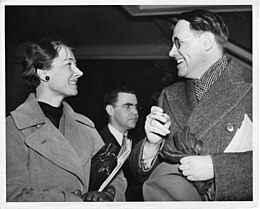Kaj Birket-Smith
| Naissance | |
|---|---|
| Décès |
(à 84 ans) |
| Nationalité | |
| Formation | |
| Activités | |
| Père |
Sophus Birket-Smith (d) |
| A travaillé pour | |
|---|---|
| Membre de |
Académie royale danoise des sciences et des lettres () Suomen Tiedeseura Société royale des sciences et des lettres de Göteborg (en) Académie finlandaise des sciences |
| Distinctions | Liste détaillée |
Kaj Birket-Smith, né le à Copenhague et mort le à Vodskov (da), est un philologue, anthropologue et explorateur danois.
Il s'est spécialisé dans l'étude des habitudes et de la langue des Inuits et des Eyaks. Membre de l'expédition Thulé de Knud Rasmussen (1921), en 1940, il devient directeur du département ethnographique du Musée national du Danemark[1].
Biographie
[modifier | modifier le code]Kaj Birket-Smith est le fils du bibliothécaire et historien littéraire danois Sophus Birket-Smith (da) et de son épouse Ludovica (née Nielsen). Il étudie à la Metropolitanskolen dès 1910.
En 1912, il prend part à une expédition zoologique dans le sud du Groenland puis, en 1918, à un voyage de recherche ethnographique dans le nord du Groenland et, en 1921-1923, participe à la cinquième expédition de Knud Rasmussen à Thulé[2]. Il entreprend ensuite un voyage de recherche archéologique et ethnographique en Alaska en 1933 et un voyage d'étude aux Philippines et en Océanie en 1951.
Il obtient son doctorat en linguistique à l'Université de Pennsylvanie en 1937. La même année, il est employé comme sous-inspecteur au Musée national, où il passe au rang d'inspecteur II en 1931 et d'inspecteur I en 1938. En 1940, il devient chef du département ethnographique et en 1946 inspecteur en chef. Il est également maître de conférences en ethnographie à l'Université de Copenhague de 1945 à 1963.
En 1920, Kaj et Minna Birket-Smith se marient. Kaj Birket-Smith est décédé en 1977, à l'âge de 84 ans. Il est enterré au cimetière de Bispebjerg.
Récompenses et distinctions
[modifier | modifier le code]- 1933 : Médaille Hans Egede de la Société géographique royale danoise[3]
- 1938 : Prix Loubat de l'Académie royale des sciences de Suède
- 1939 : Chevalier de l'Ordre du Dannebrog
- 1952 : Médaille commémorative Huxley décernée par l'Institut royal d'anthropologie de Grande-Bretagne et d'Irlande
Publications
[modifier | modifier le code]- 1916 : The Greenland bow. København: Bianco Lunos bogtr.
- 1918 : A geographic study of the early history of the Algonquian Indians
- 1920 : Ancient artefacts from the Eastern United States
- 1924 : Ethnography of the Egedesminde District with Aspects of the General Culture of West Greenland
- 1925 : Preliminary report of the Fifth Thule Expedition Physical anthropology, linguistics, and material culture
- 1928 : On the origin of Eskimo culture
- 1928 : Five hundred Eskimo words: A comparative vocabulary from Greenland and Central Eskimo dialects
- 1928 : The Greenlanders of the present day
- 1928 : Physiography of West Greenland
- 1929 : The Caribou Eskimos. Material and social life and their cultural position
- 1929 : Drinking-tube and tobacco pipe in North America
- 1930 : Contributions to Chipewyan ethnology
- 1933 : Geographical notes on the Barren
- 1938 : The Eyak Indians of the Copper River Delta, Alaska
- 1940 : Anthropological observations of the Central Eskimos
- 1943 : The origin of maize cultivation
Notes et références
[modifier | modifier le code]- (da) Cet article est partiellement ou en totalité issu de l’article de Wikipédia en danois intitulé « Kaj Birket-Smith » (voir la liste des auteurs).
- Henry B. Collins, Jr., Anthropology during the War. II. Scandinavia, vol. 48, Blackwell Publishing, , 141–144 p. (DOI 10.1525/aa.1946.48.1.02a00340
 , JSTOR 662818), chap. 1
, JSTOR 662818), chap. 1
- Paul-Émile Victor, Les Explorations polaires, tome IV de Histoire Universelle des Explorations publiée sous la direction de L.-H. Parias, Paris, Nouvelle Librairie de France, 1957, p. 338
- (da) V. Elberling et Hjelmstjerne-Rosencroneske stiftelse, Avis-aarbogen ...: Aarets begivenheder hjemme og ude i faa orde, C. A. Reitzel, (lire en ligne), chap. vb. 10, p. 161 ff.
Liens externes
[modifier | modifier le code]
- Ressources relatives à la recherche :
- Ressource relative aux beaux-arts :
- Notices dans des dictionnaires ou encyclopédies généralistes :

